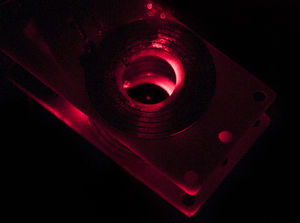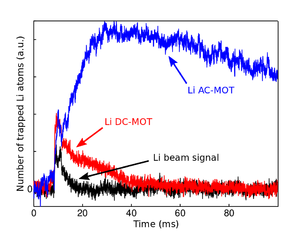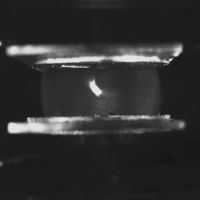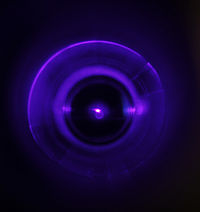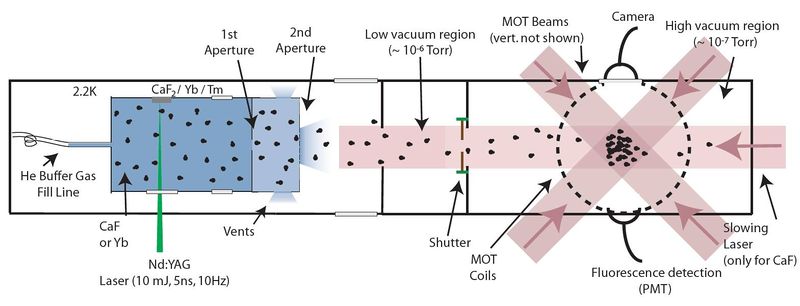LaserCooling
Contents
People
Post Docs
- Boerge Hemmerling
- Nick Hutzler
Grad Students
- Garrett Drayna
- Eunmi Chae
- Aakash Ravi
Collaborators(JILA)
- Jun Ye (PI), Matthew Hummon, Mark Yeo, Alejandra Collopy, Yong Xia
Ye Group Ultracold Molecules Website
Overview
The goal of this experiment is to load a magneto-optical trap (MOT) with calcium monofluoride (CaF) using a two-stage buffer-gas beam source (for details on buffer-gas cells see The Buffer Gas Beam: An Intense, Cold, and Slow Source for Atoms and Molecules). We first ablate a solid precursor of CaF2 with a pulsed Nd:Yag laser. The hot molecular gas then thermalizes with ~1 K Helium buffer-gas and is extracted into a beam. In such a two-stage cell, the molecular beam has an average forward velocity of 50-60 m/s. While there are many particles below typical capture velocities (~ 40 m/s) of atomic MOTs. We made use of this fact demonstrating direct MOT loading for various lanthanides (see below for details). For molecules, however, the estimated capture velocity is much lower (~ 10 m/s) and a slowing stage is required to bring a sufficient number of molecules below the capture velocity. An additional challenge is the existence of magnetic dark states in molecules. We address this problem by switching the polarization and the magnetic field of the MOT very rapidly (~6 MHz) to depopulate those dark states.
Latest News
AC-MOT of Lithium
We realized an AC-MOT for Lithium-6 on the D1 line. This transition has magnetic dark states which reduce the efficiency of a regular DC-MOT configuration. A switching of the polarization and the magnetic field actively remixes the Zeeman substates and keeps the atom in the cooling cycle. Three different time traces comparing the beam signal without trapping fields, a DC-MOT and an AC-MOT are shown in the left figure. Both, the magnetic field coils and the polarization of the molasses laser beams are switched at a frequency of 6 MHz. The improvement in the lifetime using the AC configuration is quite evident. For further details on AC-MOTs see e.g. M. Hummon, et al., PRL 110, 143001 (2013) and M. Harvey, A. J. Murray, Phys. Rev. Lett. 101, 173201 (2008).
MOT paper got accepted in New Journal of Physics
Our paper Buffer-gas loaded magneto-optical traps for Yb, Tm, Er and Ho (arXiv version) got accepted in New Journal of Physics.
Loaded magneto-optical traps for Yb and its isotopes from our buffer-gas beam source
As a first test with our new apparatus and our in-vacuum coils, we loaded an Ytterbium MOT (picture on the right).
Laser Cooling of Atoms (Yb, Tm, Er & Ho)
We first investigated laser cooling and trapping of atoms from a buffer-gas beam. We made the first buffer-gas loaded MOT, using Yb atoms as our species of interest. This MOT, which used no slowing of any kind (Zeeman slower, slowing laser, etc.), demonstrated the power of our very-slow beam technology, which we plan to use for a molecular MOT. Furthermore, this MOT demonstrated that, in principle, buffer-gas beam technology is compatible with 3D magneto-optical trapping. Owing to the universal nature of this source, we implemented MOTs of Ytterbium, Thulium, Erbium and Holmium atoms with only a change of the ablation pre-cursor and the MOT laser frequency. Thulium, Erbium and Holmium are highly magnetic species that are of interest for quantum simulation and quantum computation. These are refractory elements and have low loading rates due to the difficulties with oven sources. Our buffer-gas loaded MOTs circumvent these high temperature oven sources and allow loading rates over 10^8 /sec/shot, or over 10^9/sec cumulative. This technology could be used to co-load multiple species with little technological overhead (no multiple Zeeman slowers). Our work on these lanthanide atoms is summarized in the following article:
Buffer-gas loaded magneto-optical traps for Yb, Tm, Er and Ho. B. Hemmerling, G. K. Drayna, E. Chae, A. Ravi, and J. M. Doyle. arXiv:1310.3239 [physics.atom-ph] (2013).
Laser Cooling and Trapping of Diatomic Radicals (CaF)
We are investigating magneto-optical trapping and cooling of diatomic molecules. Laser cooling of molecules requires buffer-gas cooling to produce samples of ground-state molecules which have necessary rotational phase space densities for current molecular laser cooling schemes. We use slow beam technology developed in our group [1] to reduce the amount of kinetic energy and number of cycled photons needed to bring molecules to rest in a 3D trap.
Currently, our group is working with the radical CaF. We have produced a slow, cryogenic beam of CaF with rotational cooling, and have demonstrated cycling of over 1000 photons (and up to 10^5) using the state-of-the-art laser cooling scheme demonstrated by Shuman et al. [3-4] Current work is ongoing to measure longitudinal slowing.
References
- [1] Hsin-I Lu, Julia Rasmussen, Matthew J. Wright, Dave Patterson, and John M. Doyle. Phys. Chem. Chem. Phys., 2011, DOI: 10.1039/c1cp21206k.
- [2] D. Patterson and J.M. Doyle. J of Chem Phys 126, 154307 (2007).
- [3] E. S. Shuman, J. F. Barry, D. R. Glenn, and D. DeMille, Phys. Rev. Lett. 103, 223001 (2009).
- [4] E. S. Shuman, J. F. Barry, and D. DeMille. Nature 467, 820 (2010).
- [5] M. T. Hummon, M. Yeo, B. K. Stuhl, A. L. Collopy, Y. Xia, and J. Ye, “2D Magneto-Optical Trapping of Diatomic Molecules”, Physical Review Letters, vol. 110, no. 14, pp. 143001/1-5, 2013.
